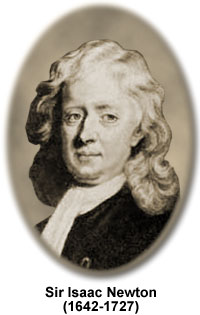Sir Isaac Newton
(1642-1727)

Sir Isaac Newton, who was ironically born the same year that Galileo died, is popularly known as one of history's greatest scientists. Many of his discoveries and theories in the areas of light, color, and optics form the basis for current scientific thought in these disciplines. In addition to his extensive work in optics, Newton is perhaps best known for his theory of universal gravitation. He also is considered one of the inventors of calculus along with German mathematician Gottfried Willhelm von Leibniz. Newton's three laws of motion are considered basic to any physics student's education. Newton, like Galileo, owed the formation of several of his discoveries to a period of self-study and scientific observation unencumbered by structured or formal education.
Newton is thought to have been born on Christmas day in 1642, a short time after the death of his father. His mother remarried, leaving him with his grandmother to be educated in Lincolnshire. Reports of his academic progress characterize Isaac as "idle" and "inattentive," which led to his being removed from school altogether by his mother. An uncle saw promise in Newton, prepared him for the university, and enrolled him at Trinity College, Cambridge, in 1661. While at Trinity, Newton studied philosophy, mathematics, mechanics, astronomy, and law.
In 1665, Newton's studies were interrupted by the closure of Trinity College because of an outbreak of plague. It was during this time, ironically, that Newton's scientific gift emerged. Newton returned to his home in Lincolnshire and in two years put forth innovative theories in mathematics, optics, physics, and astronomy. In 1667, when the college reopened, Newton was offered a position as Lucasian Professor at the age of 27. His first work in this position was on optics. Newton had been grinding his own lenses for several years in an effort to produce an improved telescope. His lens making activities led him to notice a problem with chromatic aberration. His attempt to solve this problem resulted in the development of the reflecting telescope. Newton also concluded that white light is a blend of colors that can be observed when light is passed through a prism.
During the period 1665-1669, Newton developed his "method of fluxions" which served to unify mathematical techniques and led to the 1666 development of calculus. In 1675 Leibniz, a German mathematician, employed the same method, which he termed differential calculus. Because he quickly published these results, Leibniz is acknowledged as the inventor of calculus. Newton was known to be wary of publishing because he was afraid of criticism, a character trait that left his work virtually unknown until 1672, when he published his first paper on light and color in the Royal Society's Philosophical Transactions of the Royal Society. This work formed the basis of his 1704 treatise, Opticks that explained, among other things, his experiments to reduce chromatic aberration and described the reflecting telescope. Up until his death in 1727, Newton claimed that he alone had invented calculus and accused Leibniz of plagiarism, a difficult assertion to prove since he had virtually isolated himself in Cambridge until 1684.
Newton's interest in astronomy was reinvigorated by a visit from Edmund Halley, the British astronomer best known as the namesake of Halley's Comet. This visit prompted Newton to pursue his theories of mechanics, which became the basis for his three laws of motion. His theories were published in 1687. Not only did this represent a new science, but it also placed Newton in the forefront of scientific debate and controversy. After the publication of The Principia, Newton was accused of plagiarism by Robert Hooke, an accusation that was never proved, but ironically put Newton in a similar position to Leibniz.
After this prolific period of scientific observation, experimentation, and discovery, Isaac Newton spent the rest of his life as a government official living in London, after suffering a nervous breakdown in 1693. In 1703, Newton was elected President of the Royal Society, and in 1708 was the first scientist to be honored for his work with a knighthood. Newton died in 1727. Of his funeral, the French philosopher Voltaire said "in a country where mortals are canonized, his discoveries might very well pass for miracles."
